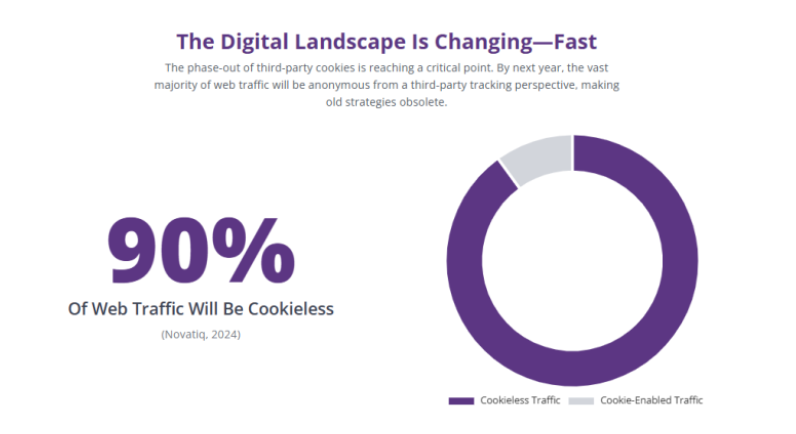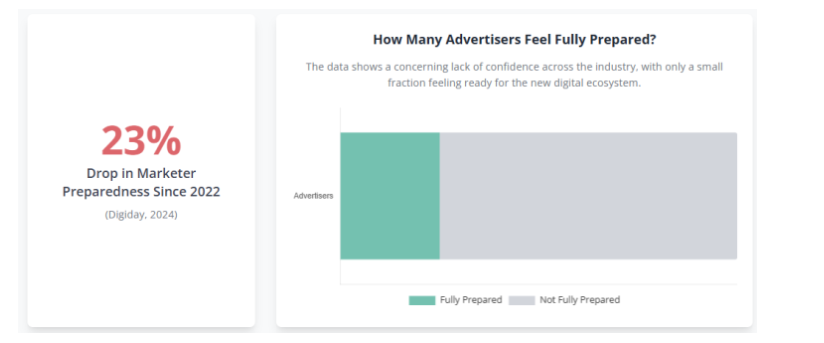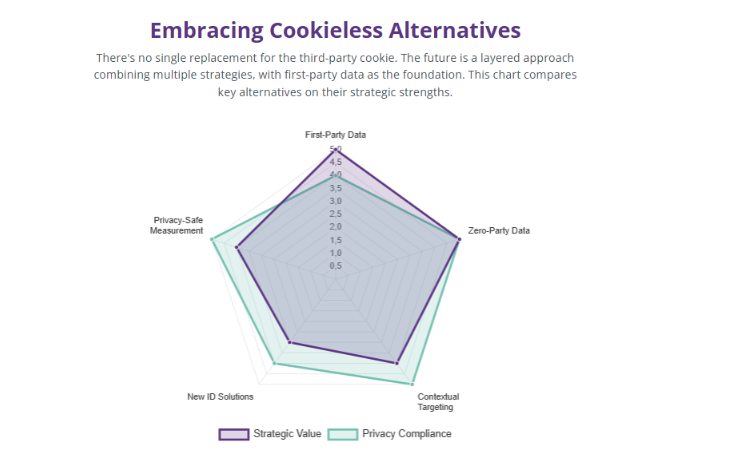
rethink how they collect, manage, and activate customer data. Privacy expectations and regulations are forcing this shift, and it’s not temporary. Google’s phased cookie deprecation means that by next year, as much as 80–90% of all web traffic will have no third-party cookies enabled according to Novatiq’s forecast, (Novatiq, 2024).
This isn’t the end of data-driven marketing it’s a reset. One that calls for a new balance between personalization and privacy.
Third-party cookies have long powered ad targeting, retargeting, and attribution. They enabled marketers to follow users across the web, but also created privacy concerns. Many users now reject tracking entirely, and laws like GDPR and CCPA have made passive data collection untenable
Marketers who still rely on cookies risk losing performance and insight. Research shows that nearly half of current strategies remain cookie-dependent, and readiness for a cookieless future has dropped 23% since 2022 (Digiday, 2024). Only a quarter of advertisers feel fully prepared (Novatiq, 2024).
The implication is clear: privacy isn’t optional anymore. It’s foundational.

Before charting a path forward, evaluate your current data maturity. Where are you on the cookieless readiness spectrum?

If third-party cookies still drive your targeting or analytics, you’re exposed. You likely lack infrastructure for owned data or a Customer Data Platform (CDP). The next step is clear: begin transitioning toward first-party data and consent-based engagement (UCPM Whitepaper, 2024).
You may already have tools like a CDP but still treat privacy as a checkbox. Outdated consent practices erode trust and invite compliance risks. Focus on unified consent and preference management, aligning privacy policies with your tech stack (UCPM Whitepaper, 2024).
If you’re already privacy-led, stay vigilant. Audit regularly, update governance, and make privacy part of your value proposition. Even the most advanced programs can drift if not maintained (UCPM Whitepaper, 2024).
Mapping stakeholders across Marketing, IT, Legal, and Analytics helps align ownership. As one internal roadmap noted, “map the full stakeholder landscape, establish a common vision, and create alignment on both current and target states” (CMO Advisory, 2024).
Moving forward means balancing customer trust, ethical data use, and marketing performance. Think of it as a three-part equation: value, ethics, and risk (CMO Advisory, 2024).
Make Privacy a Competitive Advantage. Transparency builds loyalty. Companies that proactively adapt can turn privacy into a differentiator (UCPM Whitepaper, 2024).
Secure Executive Sponsorship. Transformation requires C-level buy-in to cut through silos and sustain momentum (UCPM Whitepaper, 2024).
Invest in Unified Consent Infrastructure. Integrate cookie consent with marketing permissions into a single source of truth, often called Unified Consent & Preference Management (UCPM). This enables consistent consent management across all channels (UCPM Whitepaper, 2024).
Improve the Privacy UX. Collect consent contextually, at relevant moments, not in overwhelming forms. “Small, relevant moments” of consent gathering perform far better (OneTrust Interview, 2024).

There’s no single replacement for third-party cookies, but a layered approach works best.
First-Party Data: The cornerstone of post-cookie marketing. Build direct relationships, offer clear value, and invest in data quality and integration (Çınar & Ateş, 2022; Digiday, 2024).
Zero-Party Data: Information customers voluntarily share preferences, intentions, and feedback. It’s high-intent and privacy-safe when used transparently
Contextual Targeting: A proven, privacy-compliant method revived by AI-driven relevance. Ads align with content themes, not user profiles (Stallone et al., 2022).
Publisher and Platform Partnerships: Walled gardens like Google and Meta offer logged-in environments for targeting, though dependence is a risk (Digiday, 2024).
Privacy-Safe Measurement: Adopt aggregated or modeled attribution using clean rooms and APIs (Digiday, 2024).
New ID Solutions: Emerging identity frameworks use encrypted emails or telco data to match users without tracking (Novatiq, 2024).
None of these fully replace cookies but together, they create a viable, privacy-first ecosystem.

The end of third-party cookies isn’t the end of personalization. It’s an invitation to rebuild marketing around trust. Start with an honest audit of your current state. Educate your teams, align stakeholders, and invest in consent-driven systems.
Marketers who act now will find themselves not only compliant but competitive. As research concludes, brands that “leverage data privacy as a competitive advantage” are already leading the next era of digital marketing (UCPM Whitepaper, 2024)
Çınar, M. & Ateş, B. (2022). Academic Findings on Post-Cookie Strategies.
Digiday (2024). ‘Considerably less ready’: Marketers’ post-cookie preparedness has dropped by 23% since 2022.F
Novatiq (2024). Cookie Deprecation: How Prepared Are Marketers?
Marchitechs and OneTrust (2024). Interview on Cookieless Data Collection.
Marchitechs UCPM Whitepaper (2024). Unified Consent & Preference Management: A Privacy-First Framework.
Marchitechs CMO Advisory (2024). Cookie-less Consent Management Roadmap.
Stallone, P., et al. (2022). Contextual Advertising in the Cookieless Era.
Coop’s personalization strategy overhaul shows the power of data, automation, and ownership in driving measurable results
Get insights on how to automate omnichannel campaign execution and improve business impact with personalization.
Get insights on how journeys orchestration is converging from Marketing Automation to CDP platforms.
You need a CX data strategy to execute your CX business strategy.
Get insights on how to get ideal balance between monetizing and being in control of your customer data.
The complexity of today's MarTech stack is making Business and IT alignment a crucial MarTech discipline.
Get insights on how to facilitate CMO and CIO collaboration.
©2025 Marchitechs. All rights reserved. Privacy Policy